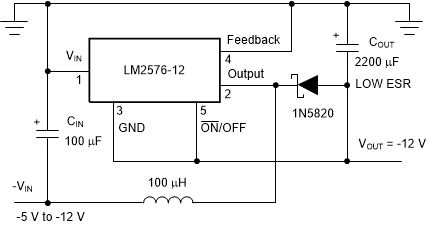JAJS782G june 1999 – march 2023 LM2576 , LM2576HV
PRODUCTION DATA
- 1 特長
- 2 アプリケーション
- 3 概要
- 4 Revision History
- 5 Pin Configuration and Functions
-
6 Specifications
- 6.1 Absolute Maximum Ratings
- 6.2 ESD Ratings
- 6.3 Recommended Operating Conditions
- 6.4 Thermal Information
- 6.5 Electrical Characteristics: 3.3 V
- 6.6 Electrical Characteristics: 5 V
- 6.7 Electrical Characteristics: 12 V
- 6.8 Electrical Characteristics: 15 V
- 6.9 Electrical Characteristics: Adjustable Output Voltage
- 6.10 Electrical Characteristics: All Output Voltage Versions
- 6.11 Typical Characteristics
- 7 Detailed Description
- 8 Application and Implementation
- 9 Device and Documentation Support
- 10Mechanical, Packaging, and Orderable Information
パッケージ・オプション
デバイスごとのパッケージ図は、PDF版データシートをご参照ください。
メカニカル・データ(パッケージ|ピン)
- NDH|5
- NEB|5
- KTT|5
- KC|5
サーマルパッド・メカニカル・データ
発注情報
8.1.10 Negative Boost Regulator
Another variation on the buck-boost topology is the negative boost configuration. The circuit in Figure 8-2 accepts an input voltage ranging from −5 V to −12 V and provides a regulated −12-V output. Input voltages greater than −12 V causes the output to rise above −12 V, but does not damage the regulator.

Because of the boosting function of this type of regulator, the switch current is relatively high, especially at low input voltages. Output load current limitations are a result of the maximum current rating of the switch. Also, boost regulators can not provide current-limiting load protection in the event of a shorted load, so some other means (such as a fuse) can be necessary.